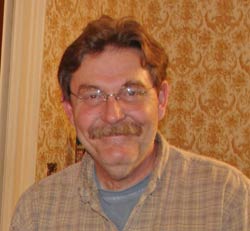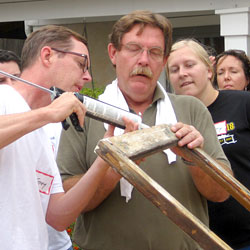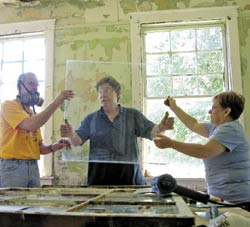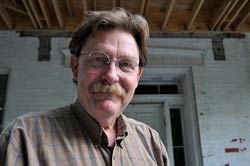Small Home Gazette, Winter 2011
A Conversation With Bob Yapp
Small Home Gazette: What’s the state of the old house movement?
 Bob Yapp: The state of the old house movement is very good in many ways and scary in other ways. What we’ve found in the Midwest is that there are a lot of people who love their old houses. But I’m also finding a huge property rights movement that’s growing every day. These are people who love their old homes but don’t want what they view as the ‘paint police’ or the ‘preservation Nazis’ telling them what to do or what not to do with their homes.
Bob Yapp: The state of the old house movement is very good in many ways and scary in other ways. What we’ve found in the Midwest is that there are a lot of people who love their old houses. But I’m also finding a huge property rights movement that’s growing every day. These are people who love their old homes but don’t want what they view as the ‘paint police’ or the ‘preservation Nazis’ telling them what to do or what not to do with their homes.
Most of this resistance is based on misconception. I am often asked to give talks to angry groups of property rights people. Usually I walk out with all of my limbs, and at the end of most of those sessions, we’re all hugging. There’s a perception with a lot of property rights people that somehow preservation is a left-wing conspiracy; that we’re out to take their property rights away. The truth is, nothing could be more conservative than preserving and conserving our built environment.
I end up talking about the economics of practicing preservation, and then they get it. No one’s taken the time to sit down and walk them through what the big lie in America is and how it’s raping historic homeowners’ pocketbooks.
SHG: The “big lie”?
Yapp: The big lie is that preservation is expensive. Preservation doesn’t cost; it pays. Retaining original materials virtually always costs less than replacing things, and it’s almost always more energy efficient.
It is the ultimate in recycling, based upon the fact that our landfills are 40 percent filled with demolition and construction debris. From time to time I train architects for the American Institute of Architects. They ask, what do you think about ‘green’ [environmentally friendly] construction? My first thought is, that’s all well and good, but what could be more green than rehabbing an existing house?
SHG: Where do we get this idea that preservation is expensive?

Yapp: Take the replacement product industry for homes. It spends hundreds of millions of dollars a year to market their products, to convince you that they’re better than what is already on your house. Does that automatically make it true? Of course not. Yet when I ask a group how many have replaced their windows or re-sided their house or any number of things that are detrimental—and cost them more than it should have—they sheepishly raise their hands.
Part of what I tell people is how they can hire someone—or do it themselves—to restore original windows in their bungalows, make them more energy efficient than a replacement window, almost as easily cleaned as a replacement window, for less money than a replacement window.
Most consumers are blown away when I walk them through this. They slap their foreheads and say, this makes perfect sense. They say, why have we been lied to? They’re mad at the replacement product industry because they’ve been duped. I’m talking about the vinyl siding industry. And doors. Go to the big-box lumberyards and look at the cheesy doors they sell. Take laminate wood floors—they cost as much as laying a 3/4-inch tongue-and-groove oak floor and having it sanded. Pre-finished flooring is another one—in accelerated testing those finishes just don’t hold up.
 Last year at the Chicago Bungalow exposition I had a large group in a window restoration seminar. I asked for a show of hands, and about 60 percent of them were there to talk to vendors at the fair that were selling replacement windows. At the end of the two-hour talk I again asked people to raise their hands, asking who was going to talk to the replacement window people, and about five percent of the people raised their hands. When I asked how many were going to talk to the window restoration companies, virtually every hand in the audience went up.
Last year at the Chicago Bungalow exposition I had a large group in a window restoration seminar. I asked for a show of hands, and about 60 percent of them were there to talk to vendors at the fair that were selling replacement windows. At the end of the two-hour talk I again asked people to raise their hands, asking who was going to talk to the replacement window people, and about five percent of the people raised their hands. When I asked how many were going to talk to the window restoration companies, virtually every hand in the audience went up.
SHG: Our bungalows are typically small, often plain, and usually not owned by avid preservationists. How does one go about addressing preservation in neighborhoods where people don’t drive through and think: Wow—what magnificent architecture! Let’s save it!
Yapp: The question is: have we done our job as preservationists? In the big picture, no, we haven’t. What the preservation movement did in the first 30 years was create this exclusivity, this hoity-toity notion that somehow preservationists were only the well heeled. The average working family couldn’t relate to that.
My whole mission in life is to take preservation through the back door by talking about economics and self-reliance. Many working families do a lot of things themselves. If they’re shown, through education, that it’s easier to repair that windowsill with epoxy than it is to rip it out, that it’s easier on their pocketbook to restore an original features.
People are concerned with the bottom line. The cultural aspects of preservation are incredibly important to me—the sense of neighborhood, of keeping interiors and exteriors of old houses intact. But we cannot promote preservation to the average working family by talking only about the cultural aspects of preservation. We have to talk about the positive economics, from the methods used to achieve home improvements to the value added to bungalows that have retained their original features.
SHG: There are many people who are sympathetic to repairing their homes or replicating features if original pieces are gone. But it can be hard to find someone who’s willing and able to do that kind of thing, especially at a reasonable cost. It’s much easier to find a vinyl siding salesman.
Yapp: That is the crisis in America for historic neighborhoods today. It is exactly what my whole career is based on. I identify and train contractors in how to do cost-effective, preservation-oriented rehab and make a profit while competing with the replacement industry, and giving excellent value to the consumer. The problem is that this is not a nationwide movement. There are probably five people like myself who do this.
In my opinion, the National Trust for Historic Preservation has dropped the ball. They need to hire 500 people like myself to go all over the country and target young, small contractors. What’s happening is that some contractors know that they can get away with overcharging, but even more importantly, they don’t know how to do work efficiently.
That’s what I teach at a school I founded. We get preservation staff and contractors from all over the country and teach them cost-effective, efficient preservation in the old mode of an apprenticeship. I’m also going into schools and starting vo-tech programs for at-risk kids, teaching them to be preservation contractors.
SHG: You sound passionate about your work.
 Yapp: This is my heart, my love—neighborhoods and preservation, especially the Arts & Crafts era. When I was a little kid, all I ever wanted to do was go into a crappy old neighborhood and buy an abandoned house. To me, that was the ultimate in being a pioneer. To do that was the most romantic thing I could think of doing.
Yapp: This is my heart, my love—neighborhoods and preservation, especially the Arts & Crafts era. When I was a little kid, all I ever wanted to do was go into a crappy old neighborhood and buy an abandoned house. To me, that was the ultimate in being a pioneer. To do that was the most romantic thing I could think of doing.
My purpose in life is to be that nerd that does all the research, digs up all the studies, finds all the objective information that’s done by not-for-profits and universities that don’t have millions of dollars to market what they’ve found. I see myself as the consumer’s advocate for old houses and their owners.











